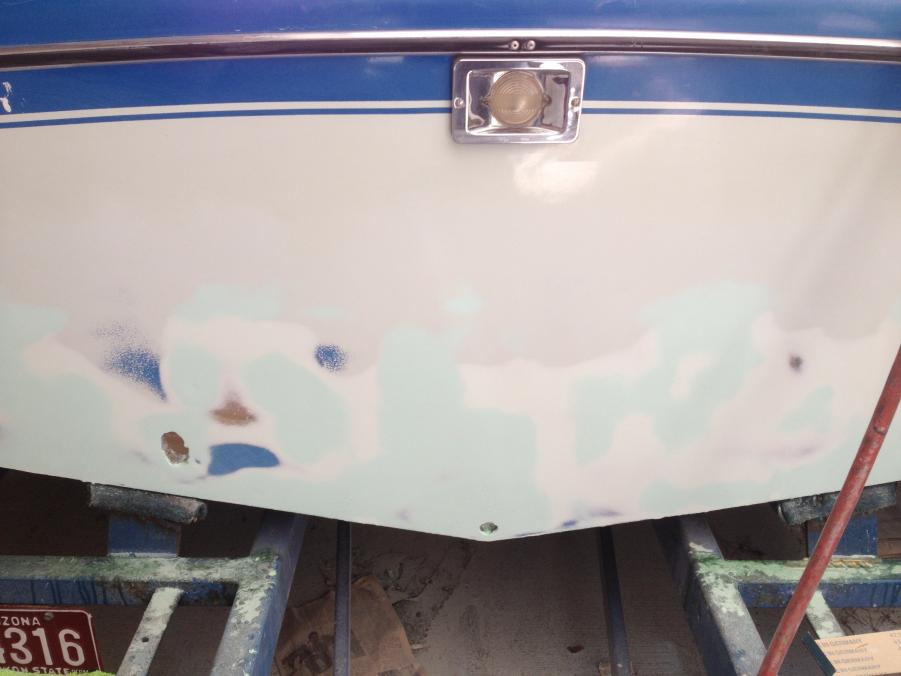Going to need one more spray and block it looks like.

Results 211 to 220 of 255
Thread: Dimarco cruiser
-
03-30-2014, 02:17 PM #211WESTERNAEROGuest
-
03-30-2014, 07:10 PM #212
-
03-30-2014, 08:26 PM #213
-
03-30-2014, 09:35 PM #214
-
03-31-2014, 05:33 AM #215
 sounds like a nice FORD coctail of colors...
sounds like a nice FORD coctail of colors... 
Hey, unless you’re dead set on sticking with GEL, don't discount the possibility of using some of the water base/waterborne special effects (pearls/transparent colors/flip flops) over a transparent base and then finishing it off with a quality automotive urethane clear...??? You could totally change those colors with candy topcoats either in a subtle way or in a BIG way…
Look up the effects on the AUTO AIR CUSTOM COLORS site, it doesnt require ovens or heat to set the paint, but it requires large volumes of air to get the stuff to flash... The DVDs that are available at the paint shops are really good at illustrating the effects/options with their paint line...
http://www.autoaircolors.com/
This one shows a magnum wagon which illustrates more subtle changes...
http://www.autoaircolors.com/gallery.html#prettyPhoto[russgerner]/0/
Check out these CANDY effect color changes with basic foundation colors like your silver/grey...
http://www.autoaircolors.com/files/4600.pdf
http://www.createxcolors.com/techchartsLast edited by 2manymustangs; 03-31-2014 at 05:47 AM.
-In a Republic, the sovereignty resides with the people themselves. In a Republic, the government is a servant of the people, and obliged to its owner, We the People..
"Remember, democracy never lasts long. It soon wastes, exhausts, and murders itself. There never was a democracy yet that did not commit suicide." John Adams
-
03-31-2014, 08:23 AM #216
-
03-31-2014, 09:34 AM #217
Even easier / better...
 -In a Republic, the sovereignty resides with the people themselves. In a Republic, the government is a servant of the people, and obliged to its owner, We the People..
-In a Republic, the sovereignty resides with the people themselves. In a Republic, the government is a servant of the people, and obliged to its owner, We the People..
"Remember, democracy never lasts long. It soon wastes, exhausts, and murders itself. There never was a democracy yet that did not commit suicide." John Adams
-
03-31-2014, 09:49 AM #218WESTERNAEROGuest
Okay, filling the holes.
Clean any old silicon, grease or gunk off the outside and inside. If you have to sand or grind it away, do it. It just fiberglass and you can build it back up or fill it later.
Go to a boat builder or repair shop and ask for a scrap of marine ply. There's no need to spend $150 for a sheet if you only need two 4" circles. offer to buy them a cold one or something. Get some wood doweling from the depot or hobby shop.
You're going to need laminating resin and mat. I used layers of 2 oz mat. Don't buy the resin from an auto store or the depot. Get it from a supply house, make sure it's fresh, this stuff has a shelf life. The older it gets the more unreliable it is on the kick time. You'll also need something called PVA, it's basically alcohol based liquid plastic wrap and used to seal out the air so you get a 100% cure and no stickiness after each coat. You can skip the PVA after each coat because laminating resin after cure is ready to accept another coat, but I like to rough body work between, so I use it between each step.
Around each hole about 2-3 inches out from the edge you need to grind or D/A sand a depression that feathers to the transom surface. Basically, grind it deep at the edge of the hole and as you get further out it blends shallower to the finished surface. I use 36 grit for this.
Small holes, like bolt holes, I drill larger first. Use a 3/8 drill for 5/16 dowel.
I like to apply masking tape to the outside of the transom and work from the inside first. So cover all the holes that need filling completely with masking tape, you're basically damming up the hole so the resin doesn't run out and this helps hold the wood in place. After you damn up the holes find something about 3/16 thick and stick it to the tape right in the middle, this will hold the wood at a depth that you can fill from the outside with out grinding it back. Cut your doweling about 1/2" longer than the transom is thick, make sure you have enough cut for each hole so you can do all the holes at once.
When you buy resin from a supplier they have all kinds of free info on mixing, temps, kick time and what not. Read it! You never want to cook the resin, meaning adding too much hardener/MEKP. Don't want to read it? Talk to the salesman, and write down some notes or whatever.I don't do much glass work so I like the slower kick times, it gives me more time to take my time.
Plan ahead, cut up some mat in pieces that you're going to need. Don't just cut up some pieces, cut them to sizes and patterns you're going to use. Cut up as many pieces as you have dowels cut about 2" x 2". Also chop up some mat into a mess or pile of tiny pieces or just buy a bag of chopped strands.
Clean all the areas with acetone.
Mix your resin, get a chip brush, lay out your two circle cut plywood, lay out your dowels and your cut pieces of mat. Brush resin into all the holes pre-wetting everywhere. Dip the dowel and 2x2 pieces of mat in the cup of resin. Lay the resined mat over the pre-drilled 3/8 hole. Push the mat into the hole with the wet dowel, you won't be able to push it through by hand as the mat starts to close around the dowel. Use an old shitty hammer you don't mind getting resin on and pound it through until it comes out the other side. Make sure the mat makes it all or most of the way through with the dowel to avoid any voids or air pockets. Do this to all the small holes. Now wet you ply wood piece and lay it in the large hole, don't push it too hard, let it rest against the 3/16 spacer in the middle of the tape. If you can put some pieces of mat in around the plywood do it now. If not, use the chopped mat and resin and start stuffing it in to all the voids. Make sure there are no air pockets. Also you really need to try and make sure you have more glass than resin. The glass is the filler, not the resin, but also make sure all the glass is wet.
Now that all your holes are filled or mostly filled, you'll have some left over resin in the cup. Take a look at it every 15 minutes or so. When it becomes hard or you can now apply the PVA. You can put it in a squirt bottle or you can brush it on, just make sure all the resin gets covered. You really want to use the PVA at this point because you're going to need to grind all the dowels and hardened mat down. The PVA is going to allow the resin to cure all the way, so the surface you have to grind won't have the waxy sticky layer that just loads up the wheel or paper.
So I'll let this sit for a couple days to allow for a full cure and shrinkage. Now you'll need to grind everything down and level with the areas that you already ground down. You'll need to cut mat patterns. So for the 4" holes you'll need circle patterns cut that get increasingly bigger, 5", 6",7", 8".
Wash the transom with a mild soap and water, making sure you've gotten the grinding dust out of all the pinholes. Let that dry fully and wash with acetone.
Mix your resin again and lay out you supplies. Wet the areas and then starting with the smallest circle pattern lay it right in the middle covering the plywood. Use the brush and wet and work out any air in the the mat. Continue this with all the patterns going from smallest to largest. You should have enough layers that the level of the repair area is now slightly high than the transoms surface. Do this for all the repair or fill areas on the transom. The process is the same for both outside and inside. When it's time, apply the PVA. Let this sit for a few days or a week, work on something else, engine, electrical, etc.
So now that everything is filled and built up a little high, it needs to be roughed in. I use a D/A sander with a 6" round pad and 80 grit paper. But you can use a mudhog or what ever you have. Take it down to a @unthair below the transom surface, being very careful to not remove too much of the materials you just put on. This type of work becomes easier and faster with practice so if you're not used to working with your hands and these tools, take your time and make it as nice as you can. It will save you more work later and materials.
Now that the high areas are below the surface I use an airfile with 80 grit to rough in the surrounding area. Again clean the surface. Mix a small batch of gel. I add a little pigment to the gel so it is a different color than the original color. I do this so when I start to long block/bodywork it flat I can see the highs and lows easier. Same concept as spraying a guide coat with out using guide coat. You can see in the pics the different colors on the different layers of gel. Mask anything you don't want over-spray on and lay it down. Clean your gun and keep an eye on the leftover gel in the mixing cup. When it starts to harden apply the PVA.
Okay, I've got work to do, I'll edit and continue later.Last edited by WESTERNAERO; 03-31-2014 at 11:31 AM.
-
03-31-2014, 10:26 AM #219
-
04-01-2014, 04:09 PM #220WESTERNAEROGuest
Hey Trouble, here's your machine porn for the day. I forgot I needed a timing indicator for the new front cover. So, here you go.



 Reply With Quote
Reply With Quote




Bookmarks